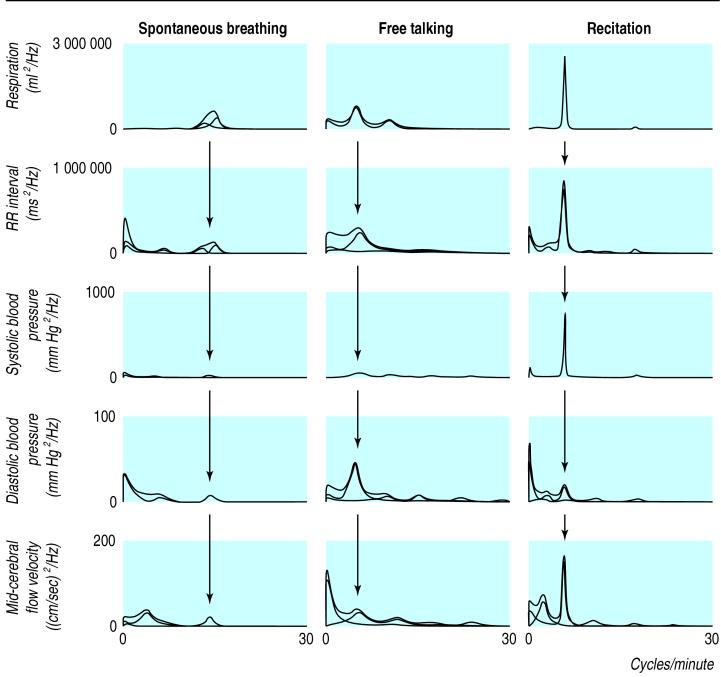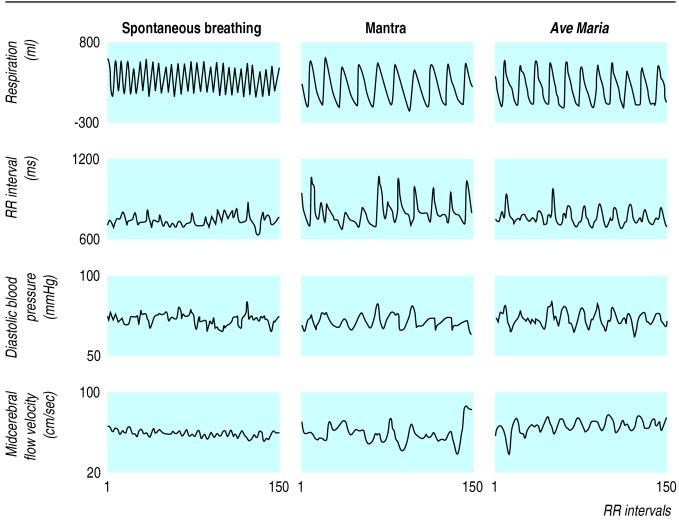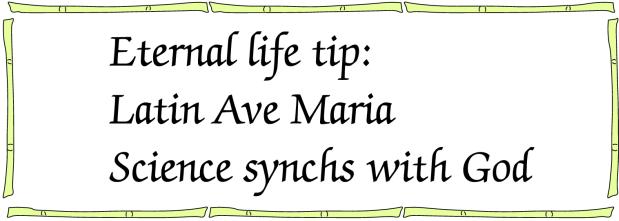Abstract
Objective
To test whether rhythmic formulas such as the rosary and yoga mantras can synchronise and reinforce inherent cardiovascular rhythms and modify baroreflex sensitivity.
Design
Comparison of effects of recitation of the Ave Maria (in Latin) or of a mantra, during spontaneous and metronome controlled breathing, on breathing rate and on spontaneous oscillations in RR interval, and on blood pressure and cerebral circulation.
Setting
Florence and Pavia, Italy.
Participants
23 healthy adults.
Main outcome measures
Breathing rate, regularity of breathing, baroreflex sensitivity, frequency of cardiovascular oscillations.
Results
Both prayer and mantra caused striking, powerful, and synchronous increases in existing cardiovascular rhythms when recited six times a minute. Baroreflex sensitivity also increased significantly, from 9.5 (SD 4.6) to 11.5 (4.9) ms/mm Hg, P<0.05.
Conclusion
Rhythm formulas that involve breathing at six breaths per minute induce favourable psychological and possibly physiological effects.
What is already known on this topic
Reduced heart rate variability and baroreflex sensitivity are powerful and independent predictors of poor prognosis in heart disease
Slow breathing enhances heart rate variability and baroreflex sensitivity by synchronising inherent cardiovascular rhythms
What this study adds
Recitation of the rosary, and also of yoga mantras, slowed respiration to almost exactly 6/min, and enhanced heart rate variability and baroreflex sensitivity
The rosary might be viewed as a health practice as well as a religious practice
Introduction
We serendipitously discovered that reciting the Ave Maria prayer and yoga mantras enhances and synchronises inherent cardiovascular rhythms because it slows respiration to almost exactly six respirations per minute, which is essentially the same timing as that of endogenous circulatory rhythms.
Healthy animals and humans show rhythmic fluctuations in blood pressure and heart rate as a result of autonomic control systems that are influenced by respiration, arousal, and activity. More than a century ago Mayer described a 10 second cycle in blood pressure (6/min) that is related to both vagal and sympathetic activity.1 This is thought to be generated either by a central nervous oscillator in the medulla oblongata or by the imperfect feedback control caused by one or other, or both, of two reflexes—the relatively slow baroreflex sympathetic response time and the faster vagal response to respiratory changes in blood pressure.2–4
These rhythms, which can be conveniently analysed by spectral analysis of cardiovascular fluctuations, have recently gained considerable clinical importance. It has been shown that reduction in their responses is an independent predictor of increased future risk after a recent heart attack,5 or in heart failure.6 A slow respiratory rate (6/min) has generally favourable effects on cardiovascular and respiratory function and increases respiratory sinus arrhythmia, the arterial baroreflex,7 oxygenation of the blood, and exercise tolerance.8 In chronic heart failure it also reduces the exaggerated sensitivity of the respiratory chemoreflex, and improves irregular breathing.8,9 Slow respiration may reduce the deleterious effects of myocardial ischaemia, and, in addition, it increases calmness and wellbeing.9 These effects result from, at least in part, synchronisation of respiratory and cardiovascular central rhythms. A respiratory rate of around 6/min coincides with and thus augments the 10 second (6/min) Mayer waves, and so increases the power of vagal respiratory sinus arrhythmia. The favourable effects of slowed breathing may be mediated, at least partly, by a modulation of autonomic activity at both central and peripheral (baroreflex) levels.
In the course of experiments in which we used power spectrum analysis to track the different effects on sympathovagal balance produced by silent compared with spoken reading, or silent compared with spoken mental arithmetic, we used the rosary as a less “arousing” control condition. The rosary is a repetition 50 times of the Ave Maria, the whole 50 repeated three times. Each cycle, recited half by the priest and half by the congregation, is—in the original Latin—normally completed within a single slow respiration. We were surprised to find that each cycle (and break) of the Ave Maria (both “priest's” and “congregation's” parts, unrehearsed) took almost exactly 10 seconds.
We believe that the rosary may have partly evolved because it synchronised with the inherent cardiovascular (Mayer) rhythms, and thus gave a feeling of wellbeing, and perhaps an increased responsiveness to the religious message.
Methods
In 23 healthy subjects (16 men, 7 women; mean age 34 (SD 8) years, weight 72.7 (3.2) kg, height 176 (1) cm) we recorded the electrocardiogram, respiration, blood pressure continuously and non-invasively at the wrist (Pilot Mod, Colin Corporation, San Antonio, TX), and midcerebral arterial flow velocity by transcranial Doppler ultrasonography with a 2 MHz probe (Multidop S, DWL, Sipplingen, Germany). We recorded spontaneous breathing (3 minute sequences) and controlled breathing (6 minute sequences) during free talking and during recitation of the Ave Maria in Latin, with one subject reciting the priest's part and another the response (no instruction was given as to time to be taken); and during six minutes of controlled breathing. Recordings were also obtained during repetition of a typical yoga mantra “om-mani-padme-om.”
The subjects studied had no previous experience of yoga but in the days before the study they were briefly instructed how to recite the mantra by a yoga teacher unaware of the aim of the study. Briefly, they were instructed to repeat the mantra with an “alive,” resonant voice; to listen to the sound produced and to let it flow freely; and then to complete the expiration comfortably after the end of the mantra and to pause if a rest was needed before the next cycle. No instruction was given as to time to be taken or any particular singing pitch.
The recordings were obtained in random order, except for the controlled breathing, which was always performed last. To control breathing we used an electronic metronome together with a visual signal, as in previous studies.10 The data were acquired on line at the sampling rate of 500Hz/channel to obtain the sequences of RR intervals, and systolic and diastolic blood pressures. By spectral analysis, we measured the amplitude and the frequency of the main fluctuations in respiration and in all the other signals, which were compared in the various conditions. In addition, using a technique derived from spectral analysis, we measured the gain of the spontaneous baroreflex by dividing the amplitudes of the oscillations in RR interval by the corresponding amplitudes of oscillations in systolic blood pressure.3,4 Finally, the regularity of breathing was assessed by the coefficient of variation (standard deviation/mean×100) of the respiratory rate, during each condition and for each subject.
Results
Both the Ave Maria and the yoga mantra had similar effects, slowing respiration to around 6/min and thus having a marked effect on synchronisation and also increased variability in all cardiovascular rhythms (table). This was seen not only in the respiratory signals but also in the RR interval, systolic and diastolic blood pressures, and in the transcranial blood flow signal. The spontaneous respiratory rate was 14.1 (4.8) per minute during spontaneous breathing; it slowed down during free talking, and it slowed down further during the recitation of the Ave Maria and of the mantra, in both cases to close to the 6/min (10 s period) Mayer rhythm.
Free talking reduced the respiratory rate more irregularly (table). The breathing was markedly more regular during slow breathing, the Ave Maria, and the mantra, whereas it was less regular during free talking than during spontaneous breathing (table). Remarkably, the regularity of breathing seen during recitation of the Ave Maria or of the mantra was similar to regularity during controlled breathing at 6/min, indicating that these methods could stabilise the respiratory rate as effectively as precisely timed control.
The spectral peaks of respiration and of all cardiovascular signals were synchronised during the Ave Maria and the mantra sequences, as they occurred at the same frequency. In addition, the spectral peak of respiration was narrower during the Ave Maria sequence than during spontaneous breathing and free talking, again as a consequence of more regular breathing (fig 1, fig 2). This increased modulation in cardiovascular rhythms influenced the cardiovascular control mechanisms: the arterial baroreflex sensitivity increased on change from spontaneous breathing to controlled slow breathing at 6/min and from free talking to the Ave Maria, or from free talking to the mantra (table).
Figure 1.

Effects (in one subject) of rhythmic rituals (Ave Maria and mantra om-mani-padme-om), compared with spontaneous breathing, on respiratory and cardiovascular rhythms. Note slow rhythmic oscillations (approximately 6/min) in all signals during recitation of prayer and mantra
Figure 2.

Power spectrums of respiration and cardiovascular signals during spontaneous breathing, free talking, and recitation of the Ave Maria. Note the left shift of the spectrums during vocal sequences, due to slower breathing. Rhythmic recitation (regular oscillations) gives narrower spectral peaks; free talking (irregular oscillations) produces broader peaks
Discussion
The timing of the Ave Maria and the yoga mantra, as normally spoken in the original language, turned out to be close to 10 seconds for each cycle. This frequency (6/min) coincides with the subjects' spontaneous Mayer wave frequency and thus enhanced this cardiovascular oscillation by synchronising sympathetic and vagal outflow. This even resulted in rhythmic fluctuations in cerebral blood flow, which might directly influence central nervous oscillations.11
Normal talking has the effect of modulating the breathing rate and in general reducing it, though it remains irregular. If the talking is rhythmic then respiration stabilises to a constant frequency. If this coincides with spontaneous cardiovascular rhythms, these rhythms are enhanced. Repeated training to slow down breathing also reduces the spontaneous breathing rate, and thus may have more than just short term effects.7–9 We have shown that recitation of the prayer or the mantra has a similar effect to that of slow breathing,7 increasing the arterial baroreflex, which is a favourable prognostic factor in long term studies in cardiac patients.5,6
Culturally distinct practices?
Is there anything linking these two geographically and culturally distant practices? Surprisingly, there is historical evidence for a link. The rosary was introduced to Europe by the crusaders, who took it from the Arabs, who in turn took it from Tibetan monks and the yoga masters of India.12 This supports the hypothesis that the similar characteristics and effects of these mantras and of the rosary may not be a simple coincidence.
The benefits of respiratory exercises to slow respiration in the practice of yoga have long been reported,8 and mantras may have evolved as a simple device to slow respiration, improve concentration, and induce calm.13 Mantras are normally repeated in sequences of more than 100, similar to the rosary (150 times). The relatively long time required to perform the entire sequence is similar to that of modern training sessions for any physical activity. This again suggests that one of the goals could be to induce physical, in addition to psychological, changes.
Owing to the very large number of repetitions of the same prayer, the rosary is unique among prayers of the Christian religion. The rhythm necessarily imposed by these repetitions induces a fixed respiratory rate at a predetermined frequency. In times when stopwatches and metronomes had still to be invented, a rhythmic formula was the easiest way to keep a reasonably accurate timing in the range of several seconds per breath, and thus a good way to learn to slow respiration to a given rate, without the need to concentrate on the respiration itself (body consciousness was not encouraged in the Christian culture of the Middle Ages). There are thus remarkable similarities in the two practices (duration and number of repetitions) and in their cardiovascular effects. The historical circumstances that brought the rosary to Europe also suggest that these similarities were not just coincidence. This practice introduced—consciously or not—a new and previously unrecognised element of oriental health practice into Western culture. The rosary might be viewed as a health practice as well as a religious practice. 
Figure.

PANOS PICTURES
Reciting the mantra stabilises the respiratory rate
Figure.

Priest: “Ave Maria, gratia plena, Dominus tecum, benedicta tui mulieribus et benedictus fructus ventris tui Jesus”
Congregation: “Sancta Maria, Mater Dei, ora pro nobis peccatoribus, nunc et in hora mortis nostrae, Amen”
Table.
Respiratory frequency and variability, and sensitivity of baroreflex, in 23 healthy adults. Values are means (SDs)
| Respiratory frequency (breaths/min) | Respiratory variability§ (%) | Baroreflex sensitivity (ms/mm Hg) | |
|---|---|---|---|
| Spontaneous breathing | 14.1 (4.8) | 21.6 (4.5) | 10.5 (5.3) |
| Controlled slow breathing | 6.0 (0.01) | 5.4 (0.7)** | 13.2 (6.6)* |
| Free talking | 7.6 (2.4)*** | 37.4 (2.2)** | 9.5 (4.6) |
| Ave Maria | 5.6 (1.1)***† | 8.3 (1.8)**‡ | 11.5 (4.9)† |
| Mantra | 5.7 (0.6)***† | 6.2 (0.7)**‡ | 12.3 (3.6)† |
P<0.05, **P<0.01, ***P<0.001 v spontaneous breathing; †P<0.05, ‡P<0.001 v free talking.
Coefficient of variation (SD/mean×100) of respiratory frequency, for each subject during each recording.
Footnotes
Funding: None.
Competing interests: None declared.
References
- 1.Mayer S. Studien zur Physiologie des Herzens und der Blutgefaesse 6. Abhandlung: ueber spontane Blutdruckschwenkungen. [Studies on the physiology of the heart and the blood vessels 6. Discourse on fluctuations in blood pressure.] Sitz Ber Akad Wiss Wien, Mathe-Naturwiss Kl Anat. 1876;74:281–307. [Google Scholar]
- 2.De Boer RW, Karemaker JW, Strackee J. Hemodynamic fluctuations and baroreflex sensitivity in humans: a beat-to-beat model. Am J Physiol. 1987;253:680–689. doi: 10.1152/ajpheart.1987.253.3.H680. [DOI] [PubMed] [Google Scholar]
- 3.Sleight P, La Rovere MT, Mortara A, Pinna G, Maestri R, Leuzzi S, et al. Physiology and pathophysiology of heart rate and blood pressure variability in humans: is power spectral analysis largely an index of baroreflex gain? Clin Sci. 1995;88:103–109. doi: 10.1042/cs0880103. [DOI] [PubMed] [Google Scholar]
- 4.Piepoli M, Sleight P, Leuzzi S, Valle S, Spadacini G, Passino C, et al. Origin of respiratory sinus arrhythmia in conscious humans: an important role for arterial carotid baroreceptors. Circulation. 1997;95:1813–1821. doi: 10.1161/01.cir.95.7.1813. [DOI] [PubMed] [Google Scholar]
- 5.La Rovere MT, Bigger JT, Jr, Marcus FI, Mortara A, Schwartz PJ. Baroreflex sensitivity and heart-rate variability in prediction of total cardiac mortality after myocardial infarction. Lancet. 1998;351:478–484. doi: 10.1016/s0140-6736(97)11144-8. [DOI] [PubMed] [Google Scholar]
- 6.Nolan J, Batin PD, Andrews R, Lindsay SJ, Brooksby P, Mullen M, et al. Prospective study of heart rate variability and mortality in chronic heart failure: results of the United Kingdom heart failure evaluation and assessment of risk trial (UK-heart) Circulation. 1998;98:1510–1516. doi: 10.1161/01.cir.98.15.1510. [DOI] [PubMed] [Google Scholar]
- 7.Bernardi L, Gabutti A, Porta C, Spicuzza L. Slow breathing reduces chemoreflex response to hypoxia and hypercapnia and increases baroreflex sensitivity. J Hypertens. 2001;19:2221–2229. doi: 10.1097/00004872-200112000-00016. [DOI] [PubMed] [Google Scholar]
- 8.Bernardi L, Spadacini G, Bellwon J, Hajric R, Roskamm H, Frey AW. Effect of breathing rate on oxygen saturation and exercise performance in chronic heart failure. Lancet. 1998;351:1308–1311. doi: 10.1016/S0140-6736(97)10341-5. [DOI] [PubMed] [Google Scholar]
- 9.Friedman EH, Coats AJS. Neurobiology of exaggerated heart rate oscillations during two meditative techniques. Int J Cardiol. 2000;73:199. doi: 10.1016/s0167-5273(00)00214-x. [DOI] [PubMed] [Google Scholar]
- 10.Bernardi L, Wdowczyc-Szulc J, Valenti C, Castoldi S, Passino C, Spadacini G, et al. Effects of controlled breathing, mental activity and mental stress with or without verbalisation on heart rate variability. J Am Coll Cardiol. 2000;35:1462–1469. doi: 10.1016/s0735-1097(00)00595-7. [DOI] [PubMed] [Google Scholar]
- 11.Cencetti S, Lagi A, Cipriani M, Fattorini L, Bandinelli G, Bernardi L. Autonomic control of cerebral circulation in normal and impaired control of peripheral circulation. Heart. 1999;82:365–372. doi: 10.1136/hrt.82.3.365. [DOI] [PMC free article] [PubMed] [Google Scholar]
- 12.Lehmann J. Die Kreuzfahrer. Munich: Bertelsmann; 1976. [Google Scholar]
- 13.Hewitt J. London: Random House; 1983. The yoga of breathing posture and meditation. [Google Scholar]


